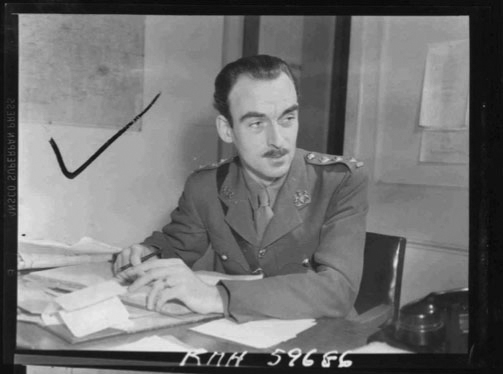
ABOVE: Captain King Whyte poses for a picture at his desk, England, 21 January, 1946. Photo by Sgt. Karen Hermeston.
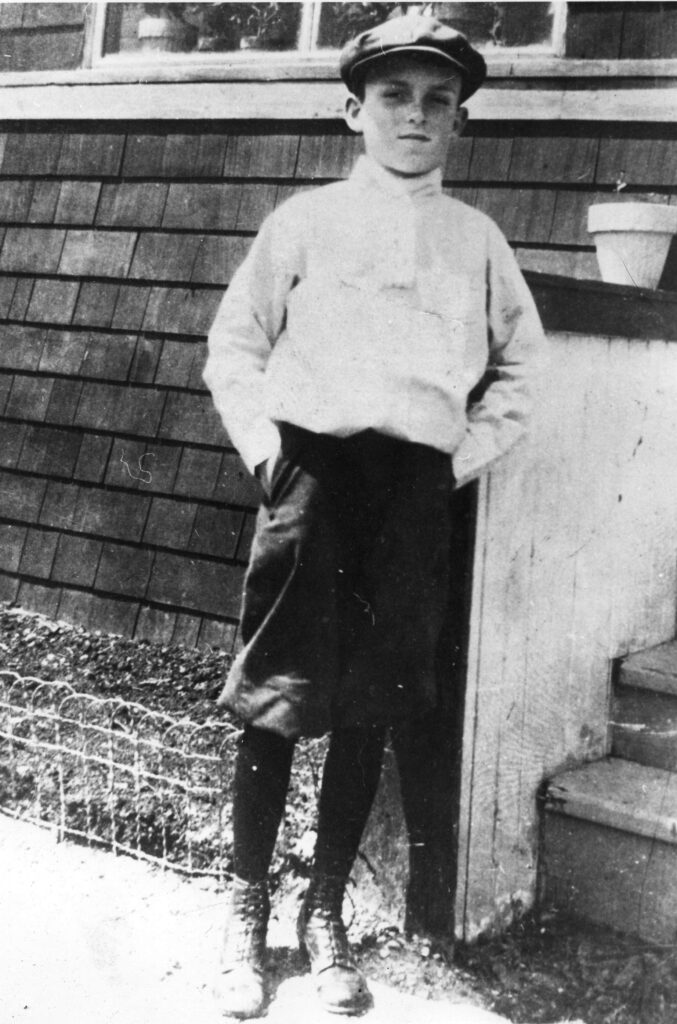
James Patrick Whyte – approximately 10 years old, Winnipeg, 1921-1922. Photo courtesy Maureen Whyte.
Born James John Patrick Whyte in Montreal, 1911, Jim Whyte would spend most of his early youth growing up in Montreal and Winnipeg, and later travel across the U.S., making stops in San Francisco, Nevada and Arizona, to name a few. By his late teens, Jim Whyte was convinced by his vaudeville agent at the time to change his name, commenting that the name Jim was all too common and would not resonate with people. So it was that an ad would appear in the Reno Evening Gazette, on December 6th, 1930, announcing the King Whyte Players‘, debut on Monday, December 8th, at the Granada Theatre in Reno, Nevada.
The King Whyte Players would open with a presentation of, “Peg O’ My Heart,” described in the Reno Evening Gazette as a “serio-comic play”. Not only would King direct the play, but he would also play the part of the villain, Christian Brent. King Whyte would be 19 years old at the time. 1Reno Evening Gazette, Saturday December 6, 1930, page twelve.
During an interview in the summer of 2016, daughter Maureen Whyte would think back on her Grandmother Kee Whyte, “My Grandmother was born in Scotland. Her Father was Scottish and her Mother was born in Gibraltar. They lived in a number of different places eventually ending up in New Mexico. So they travelled around. My Father was a deputy sheriff in Arizona for a short time. So they did all kinds of things and I think they did so well because they could b.s. a bit too.”
Years later, arriving via Santa Monica, Calif., King Whyte would take up a position as the managing director of the Tucson Little Theatre in 1934. King would take the lead in the play, “Louder Please“, as a “high powered publicity executive,” and later “interpreting the role of James Dyke, the tragic youth who has been condemned to the gallows,” in the play, The Valiant. 2Tuscon Daily Citizen, Tucson, Arizona, Tuesday March 12, 1935, page eight.
At an historic Spanish Catholic mission located about 10 miles south of downtown Tucson, Arizona, King Whyte, 23, would marry, Peggy Tatum, 22, May 3, 1935. 3Tuscon Daily Citizen, Tucson, Arizona, Saturday May 4, 1935, page fourteen.
Newly married, King Whyte would further establish himself in finding employment with the advertising department of the Tucson Daily Citizen, and later as manager-announcer for radio station KVOA. 4Tuscon Daily Citizen, Tucson, Arizona, Wednesday September 18, 1935, page four. Not long after, King and Peggy would welcome into the world a son, Anthony John Whyte. 5The Arizona Daily Star, Sunday Morning edition, June 14, 1936, page one.
As a manager-announcer-actor in the local scene, King Whyte would appear on numerous occasions in the social columns, once to referee a softball match between the orchestras from the Pioneer, and Santa Rita Hotels. The Pioneer Orchestra who lost the match (18-17), would blame it on the officiating of King Whyte, who jokingly admitted that his knowledge of the game, “is none too great.” 6Tuscon Daily Citizen, Tucson, Arizona, Tuesday July 7, 1936, page twelve.
In June, 1937, King Whyte would star alongside Jimmy Whittle, to form a song and piano duo in a 15-minute program on KVOA, “dedicated to the season’s crop of June Brides.” King Whyte’s selections would include, ‘Let Me Call You Sweetheart,’ Cadman’s ‘At Dawning,’ ‘The World Is Mine Tonight’ and ‘Sweetheart Waltz’ from the motion picture, ‘Maytime’ “ 7The Arizona Daily Star, Sunday Morning edition, June 6, 1937, page thirteen.
Sadly, the union between King Whyte and Peggy Tatum would not last long. Public records submitted to Judge William G. Hall presented a divorce judgement in favour of the plaintiff, Peggy T. Whyte vs King Whyte, in July, 1938. 8The Arizona Daily Star, Wednesday Morning edition, July 28, 1937, page twelve.
After his divorce to Peggy Tatum, ‘noted radio announcer’ King Whyte would reappear in Ohio, joining the announcers staff of WLW and WSAL in Cincinnati. 9The Cincinnati Enquirer, Sunday May 7, 1939, page 25. It was here at WLW, Cincinnati, that King Whyte would conduct the late night broadcast of the ‘Moon River’ program. 10Johnson City Chronicle,(Tennessee) Friday Morning, August 11, 1939, page two.
Interrupting what was up until then, a successful career in radio and theatre, arrived a notice from the Canadian consulate in Ottawa, to report immediately for military duty. Before leaving his position and mindful of what lay ahead, King Whyte wrote the following verse for inclusion on the Moon River program;
In a far-off foreign land Where lies the bones of ancient warriors They who shed their blood in long-forgotten wars, There go I, a stranger, To mingle youth's young life with their dead, moldy sores, And in the years to come Think not of me as one who followed duty, But he who knew his fate and kept his tryst On some historic battle ground With blood the god of war to sate.11The Dayton Daily News, Monday September 11, 1939, page thirteen
It was reported that King Whyte of Zanesville, Ohio, was believed to have been the first radio announcer in the United States to have quit his job in order to join the war in Europe." Radio Announcer Gets Army Duty Order - The Times Recorder, (Zanesville, OHIO) Thursday, September 14, 1939, page 2.
King Whyte would return to Canada and resurface in Winnipeg where he would meet Dorothy Alt, both of whom were working at the CBC at the time.
Born in 1917 in Plum Coulee, a small, mainly German Mennonite community not far from Winnipeg, Manitoba, Dorothy Alt would grow up in a musically inclined family where she learned to play piano, and sing at church.
This talent to sing, along with her natural good looks would motivate Dorothy, still in her teens, to visit one of her sisters, who was working as a nurse in Detroit, to enter a talent competition, which she would win.
Dorothy would blossom into a successful career singing with well known orchestra’s of the time including, Luigi Romanelli, Lucio Agostini, Percy Faith and Harold Green.
Securing a job as a CBC producer, King Whyte would continue where he left off in the U.S., producing programs that featured his poetry readings and musings over the Canadian western networks with, “Rhymes and Ramblings” and “Memories.” 12The Drumheller Review, Drumheller, Alberta, Thursday, March 28, 1940, page three.
As Maureen would recall, her Mom who was singing on live radio for the CBC at the time was not too taken with King when they first met, “…my mother didn’t want to go out with him, she told me she didn’t like him…he kept inviting her skating and for hot chocolate…eventually she said he grew on her…but, in the beginning she did not want to commit.”
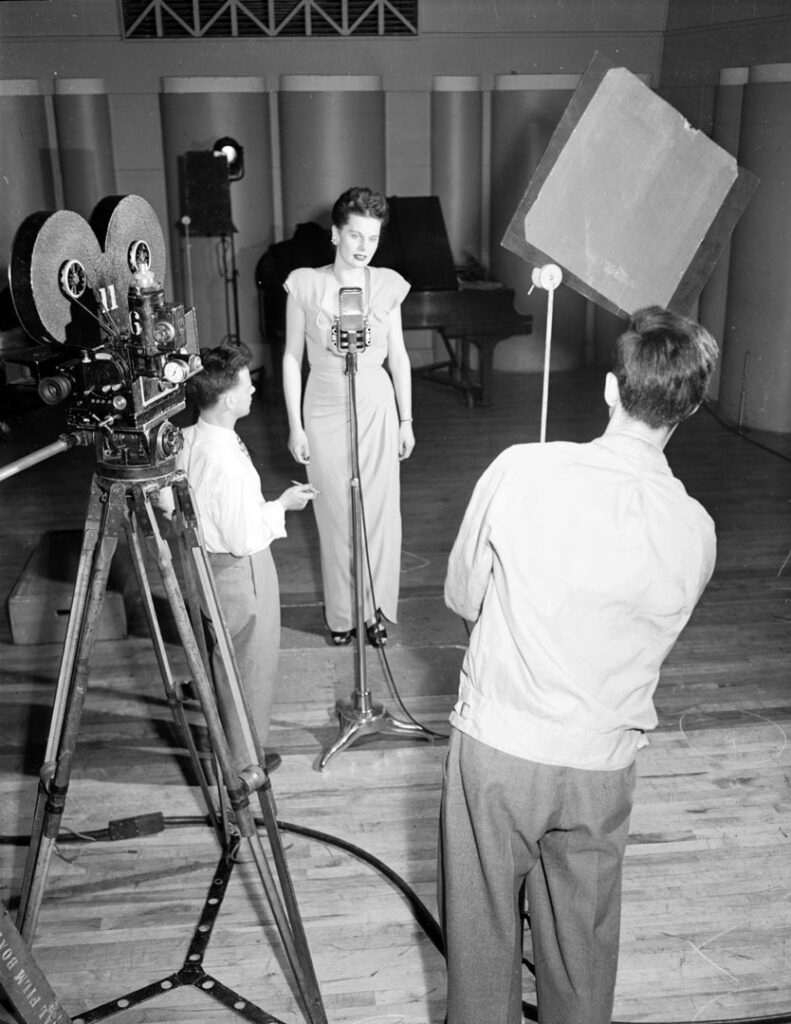
King and Dorothy would be married in 1940, and soon after, would move from Winnipeg to Montreal, where King got a job with the advertising agency of Cockfield and Brown. In Montreal, Both King and Dorothy would quickly establish themselves in the local entertainment scene.
At a benefit held in Montreal by the H.M.C.S. Saguenay Chapter of the I.O.D.E. (Imperial Order Daughters of the Empire), King Whyte, master of ceremonies would host a Navy-inspired fashion show; “Highlight of the evening will be “Navy Blues” songs by Mrs. King Whyte.” 13The Montreal Daily Star, Monday, March 3, 1941, page 17.
King Whyte would write and produce a special program in support of the Poppy Day sales of Greater Montreal over CFCF, featuring Dorothy Whyte, in November 1941, and in March 1942, Dorothy Whyte would perform, singing ‘modern melodies’, accompanied by the Lucio Agostini Orchestra. 14The Gazette Montreal, Thursday, November 6, 1941, page 2.
Eventually, the Army would summon King to Ottawa, where he would take on the position as Liaison Officer, at the Directorate of Public Relations in August, 1943. Part of his duties at that time was, “to facilitate the despatch, transit and delivery of overseas still pictures and motion picture film.” Less than a year later, in early June 1944, King Whyte would report to C.M.H.Q. in England;
“MEMO – You will be interested to know that Lieut.King Whyte has now reported for duty here and we are placing him in charge of handling routine S.H.A.E.F. film through censorship etc. Judging by this morning’s reports he is likely to be a very busy man! (Memo dated, 7th JUNE, 1944, from GORDON SPARLING, Capt. o.i.c., Cdn Film and Photo Section P.R. Services, to Lieut. C.F. Quick c/o D.P.R. (ARMY), 54, Albert Street, Ottawa, Ont.)
Only days later, King Whyte would find himself sitting next to J.E.R. (Jack) McDougall, officer commanding of the Canadian Army Film Unit, at the American theater, 35 Davies Street, to witness history in the making;
“EXCERPT FROM J.E.R. McDOUGAL FIELD DIARY, 9TH JUNE 1944 – On the afternoon of Wednesday the 7th we had received 600 feet from Sgt. Bill Grant. The night of Wednesday the 7th, at the American theater at 35 Davies St., the theater was packed with senior American officers. There were also the censors and, representing Canada, King Whyte, Sgt. Stone and myself. We sat through three or four thousand feet of rather dull American stuff, having to do mainly with preparations and embarkation. Then came Grants stuff. And it was good. It was bloody good. All through the theater you could hear people whispering to each other and muttering as good shot followed good shot. When it was all over there was much excitement and planning on how to get it to Washington the quickest possible way. I left in the middle of the flap, happy and wondering how long our invasion luck can last. There’s nothing left for us to scoop the world on except Tokyo.”
At the same time, King Whyte would take on the role as the new voice of the Canadian Army Newsreels;
“THE VOICE – The owner of the pleasant new voice, the commentator for the Canadian Army Film Unit Lt. King-White, who crossed the pond over three months ago and has been recording on our behalf ever since. Back in America King-White was well known in South Western United States and Canadian radio circles prior to enlisting and joining Public Relations at NDHQ. (The Viewfinder – Prod. 1 – 30 August 44 – Page 3 – Roll 13)
The Canadian Army Newsreel (CANR) was launched in November of 1942 with Lt. J.E.R. (Jack) McDougall awarded the honour of being the first commentator for the first issue of the Canadian Army Newsreel.15The Viewfinder Over the years, several voices from the ranks would be featured, and by coincidence, King Whyte would be sharing the newsreel commentator duties with another Winnipeg radio announcer, Sgt. Wilf Davidson, formerly of Manitoba radio station CKY in Winnipeg. 16Winnipeg Free Press, Wed, January 10, 1945.
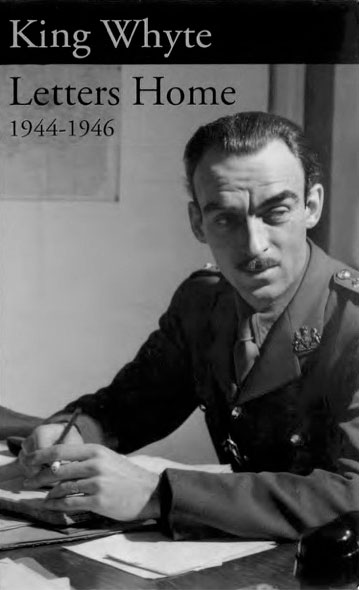
King Whyte, in addition to being a censor, and newsreel commentator, would on occasion take a film crew out into the city to record some of the damage wrought by the German bombs. Some of this footage would find its way into the Canadian Army Newsreels. 17June 16th, and 29th. Letters Home. On occasion, when arriving back at his flat, King Whyte would stop in at the Gloucester Road tube and bomb shelter and have a cup of tea. It was at this shelter that King Whyte would fall ‘in love again’. In a letter home to Dorothy, King Whyte would write,
“…This time her name is Maud and she is just six months old. Little Maud is one of the shelterers and she is the sweetest little thing you ever saw. My eyebrows seem to fascinate her. She always tries to take them off.” 18Letters Home – London, England, July 28, 1944
Maureen Whyte would add, “…Dad got to know a woman, and her child, Maud. Maud was an infant, and baby clothes were rationed, so my Mother would send packages to London for Maud. It was impossible to get things, and my Mom sent shoes, sleepers, and sweaters. Maud and her Mother were killed in an air raid. I’ve gone through the photographs, (taken by King Whyte during the war), and there are pictures of children, but I haven’t been able to definitively say, this is Maud. And, I didn’t know the last name. I looked in the death registers in Britain. I knew the approximate time that Maud died, but I didn’t see her there.”
Maureen Whyte, born in 1950, was one of two daughters, (her older sister Kathleen was born in 1948), discusses how she first became aware of the letters that inspired the book;
“Actually what’s interesting is, I didn’t know about the letters ’til the early 1980’s. My mother was cleaning the basement and she called me and said, you know, I have a trunk in the basement, and I need help getting it upstairs. I’m going to get rid of it. The trunk had always been under the basement stairs. Even as a kid I don’t think I ever opened that trunk. So, we brought it up and it was hundreds of letters and photographs. And I said, I have to read these, this is fabulous, and I looked at the photographs. So, she put everything in shopping bags, and gave it to me and said, “Get them published, Dear.” Letters Home was first published in 1996 by Seraphim Editions, with a second printing in 2007.
BERGEN-BELSEN
In a powerful example of how the book, Letters Home, would serve as witness to the tragedy of war, King Whyte would be assigned to report on the conditions of the Bergen-Belsen concentration camp for Radio Luxembourg in April, 1945. Maureen Whyte describes what happened when years later she received a phone call in 2012;
“…my friend said you could only call it a God moment. Because there are so few that happen in your life. A few years ago I was making my morning tea, and the phone rang, and the caller said, “Are you King-Whyte’s daughter?” And I said, yes. And he said, “Your father helped my family.” And I said, ‘Oh?’ He said, “There’s a picture of my mother in Letters Home, and she was a prisoner at Belsen.” I knew immediately who she was because I’d struggled a bit with whether to put that photograph in the book in the first place.
Anyway, he introduced himself as David, and said his mother had passed away a few years ago, and a friend had passed the book along to him, because there was a section on Belsen. Dad met David’s mother and aunt who were teenagers in Belsen in April 1945. They approached him and asked if my Dad could contact their father who was a Rabbi in New York, and tell him that they were still alive. My Dad went through the Red Cross, and eventually got in touch with the Rabbi and told him the daughters were alive but his wife had been gassed.
So, my Dad corresponded back and forth with the Rabbi, and the girls ended up having to stay for a period of time because David’s mother had Typhus, and she couldn’t be shipped anywhere, and the States wouldn’t take them for a while. So, her and her sister were going to be reunited with their Dad but it took quite a bit of time. Months and months.
When my Dad got home from World War II he told my Mom he had somebody he had to see in New York. He went to New York to see the Rabbi and tell him what he had seen in Belsen. They got to know each other a little bit through letters. My Dad’s letters to David’s Grandfather are in the in the Holocaust Museum. If our parents had had any idea in April, 1945, that their children would be speaking in 2012, when they’re gone I think they would have been pleased and probably shocked. David and I had an instant connection. David said he grew up knowing about this Canadian soldier, that his Grandfather called the Canadian Saint. He’d say, “That Catholic guy, he’s a Saint!”
With the war winding down, King Whyte would be on hand a month later to witness the surrender of the German delegation to Field Marshal Montgomery on May 5th, 1945.
Letters Home – May 5, 1945 – Somewhere in Germany – Well, the war in the west is over. Yesterday I was the only Canadian (correspondent) present when field Marshal Montgomery met with the German delegates and signed the papers of unconditional surrender. It was a wonderful sight. You will see it in the newsreels—I was standing beside the camera. The day before, I went forward and shook hands with the Russians. A chap by the name of Larry Solon and I were the first correspondents to make contact.”19Letters Home – May 5, 1945
THE TANK
King Whyte, would find himself writing home about yet another sombre encounter during the war, recounting a close call on the streets of Bremen;
Letters Home – June 12, Brussels, Belgium, 1945 – “I wanted to tell you a story of how a chap shot himself. It was while we were going into Bremen. The Germans had planted 500 pound aerial bombs as mines and one of our tanks hit one. It took the turret right off the tank and threw the tank itself upside down. All the crew were killed with the exception of one man. I wasn’t very far away when the thing happened, just about a hundred yards. I rushed over to the tank and shouted through one of the slits. I could hear the poor guy moaning inside. Men from another tank came over but there wasn’t a thing we could do for the poor fellow inside. He told us that part of the tank (where the turret normally joins) was laying across his legs almost at his hips. How he was still conscious I don’t know but he knew he had bought it. There was no way in the world that the tank could be turned right side up in time to save his life. He asked to be shot as the pain was getting unbearable. But, we couldn’t see him to shoot him. So, I lowered my pistol on its lanyard to him and he did the job himself. Then I pulled the pistol back out of the tank. I’ll never forget that fellow—he had a lot of guts.” 20Letters Home – First Edition: 1996, page 79-80.
Now a Captain, King Whyte would finally realize his dream of being an actor when he would be offered a role in a British film as a Canadian Colonel in, ‘Christmas Weekend’. The film would be released publicly under the title, ‘This Man is Mine.’
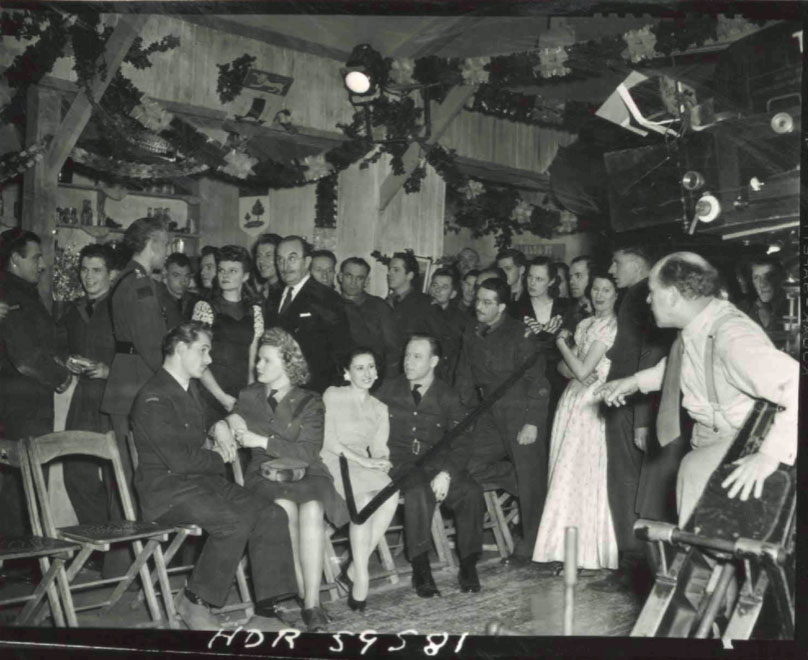
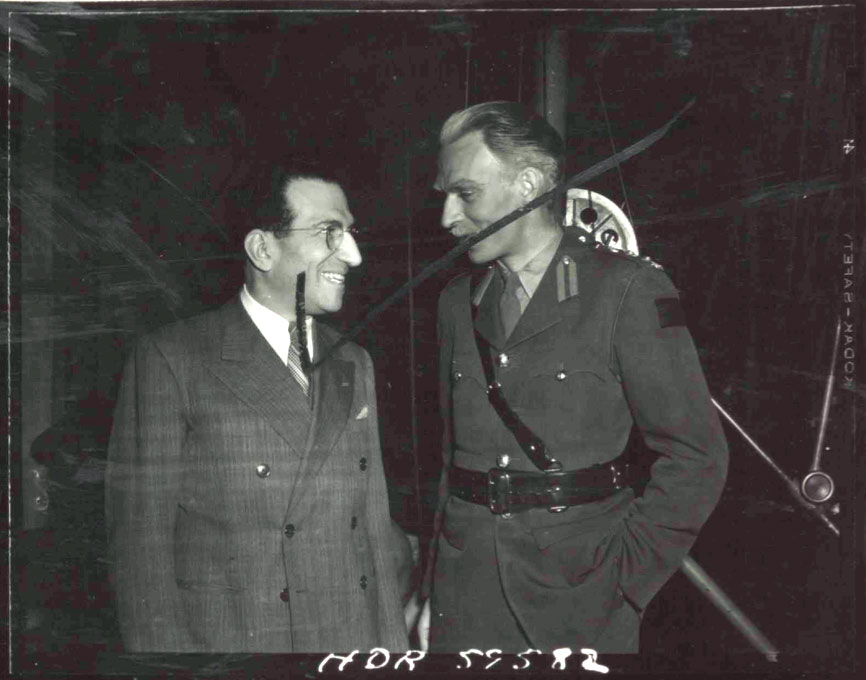
LEFT: “A number of Cdns while awaiting repat, and some who are stationed In London, are having the thrill and honour of working on a real movie production at a London studio. The film is ’Christmas Weekend’ and some of the stars working on the production are; Nova Pilbeam, Jeanne De Casalis, Glynis Johns, Tom Walls & Hugh McDermott. Caption credit: Lt. Harold D. Robinson. Numerical Album No. 057.
RIGHT: “During a break on the set, Captain King Whyte (playing a Canadian Colonel in the film) chats with the producer Joseph Friedman.” Date: 12-14 Jan. 46 Photo credit: Lt. Harold D. Robinson. Numerical Album No. 057. Library & Archives Canada. For cast and credits of the film (This Man Is Mine), please visit the IMDb here.
King Whyte also managed to find time during the war to narrate on two National Film Board productions; Northwest by Air and, Land for Pioneers.
What might have been one of his last duties at the Film Unit, Captain King Whyte would record his last take as newsreel commentator in Canadian Army Newsreel Issue no. 106 in February, 1946;
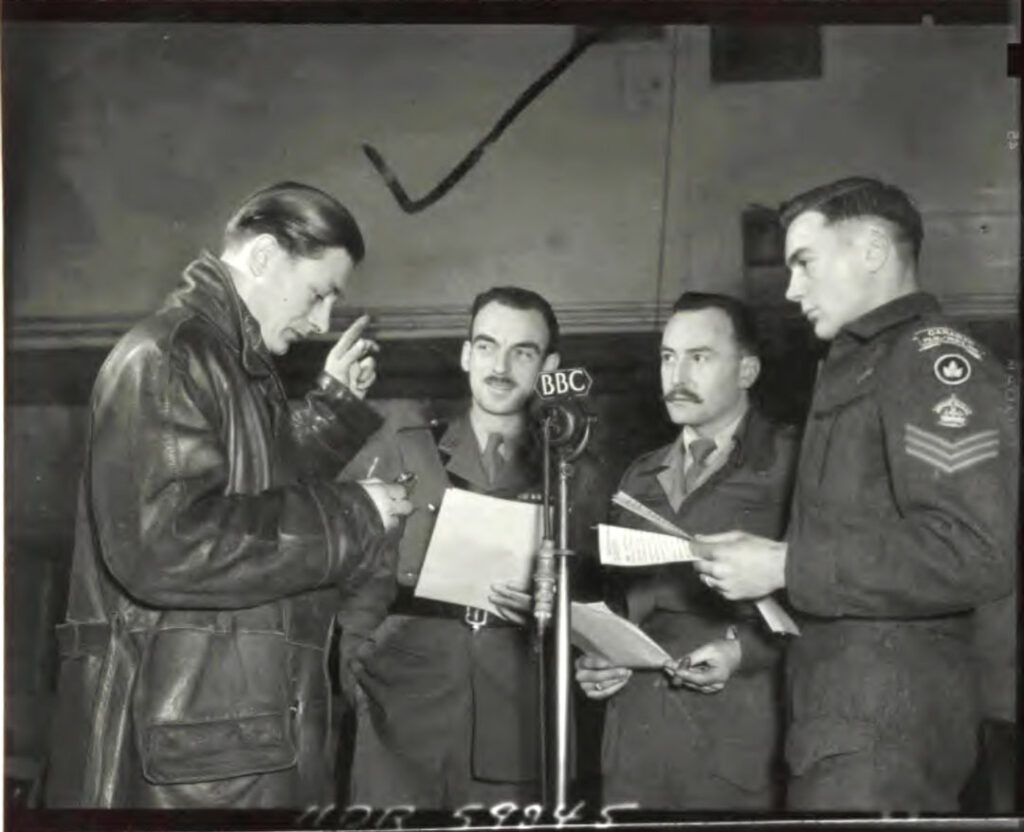
“Film Unit Did Last Newsreel – With the Canadian Forces Overseas, Feb. 28 — (CP) —The Canadian Army Film Unit in London, which supplied Canadian forces with movie new’s for more than three years, recently issued its 106th and last edition of the Canadian Army Newsreel. Recorded every Tuesday and issued the following Friday, the newsreel, duplicated into 50 copies, was distributed by the Public relations Services to units in the United Kingdom, the continent and Canada. Bulk of the material used was shot in the field by cameramen recording the action of war from a Canadian angle. Several were killed and wounded, and many won awards for valor. Officer Commanding the Film Unit was Maj. Gordon Sparling, Montreal, with Capt. Gordon McClain, Toronto, producer. Announcer was Capt. King Whyte, Montreal, who has been announcing in the United States and Canada for the last 15 years….21The Expositor, Brantford, Thursday, February 28, 1946.
After the war, King Whyte would return home to Dorothy in Montreal, and continue on with the advertising firm of Cockfield and Brown before he was transferred to Toronto, working at the Toronto Star, as well as producing a poetry program, ‘Moonlight Serenade‘ at the CBC. 22CBC Times, October 1954 Dorothy would continue to perform on CBC, and on one occasion was on hand to star as a guest with Percy Faith and his orchestra, when radio station CFRA officially hit the airwaves on May 3, 1947. Dorothy would perform alongside other entertainers in front of 8,000 at CFRA’s Ottawa Auditorium, 413 O’Connor Street. 23https://broadcastinghistory.com/listing_and_histories/radio/cfra-am
During the 1950’s, King Whyte, now widely regarded as an avid sportsman and outdoorsman, would literally channel these interests, into a broadcast over CBC TV at the end of the N.H.L. games with, The King Whyte Show. 24The Ottawa Citizen, Saturday, October 8, 1955, page 3.
THE KING WHYTE SHOW "King Whyte, columnist for the Toronto Star and commentator on CBC radio's Ontario Sportsman show, presented films and interviews on outdoor sports, hunting, fishing, and boating in this fifteen minute program, which followed the hockey broadcast. The broadcasts were produced by Ty Lemburg (1956-59) and Wilf Hayden (1959-62)." Credit: CBC Television Series, 1952-1982 by Blaine Allan
(Many of the shows and films featuring King Whyte can be readily found by contacting the archives of the CBC and Library & Archives Canada.)
During his career, King Whyte would use his television and radio fame to help the less fortunate, raising funds by attending dinner functions related to the outdoors. One cause close to his heart was donating skates to First Nations children. The idea came when King Whyte while traveling in the north country saw a group of children skating on a frozen lake, taking turns using a limited pair of skates. 25The Windsor Star, Friday, December 16, 1960, page 7.
King Whyte soon became a major draw at various sport banquets, and sportsman shows, and was sometimes featured in full page advertisements in eastern Ontario.
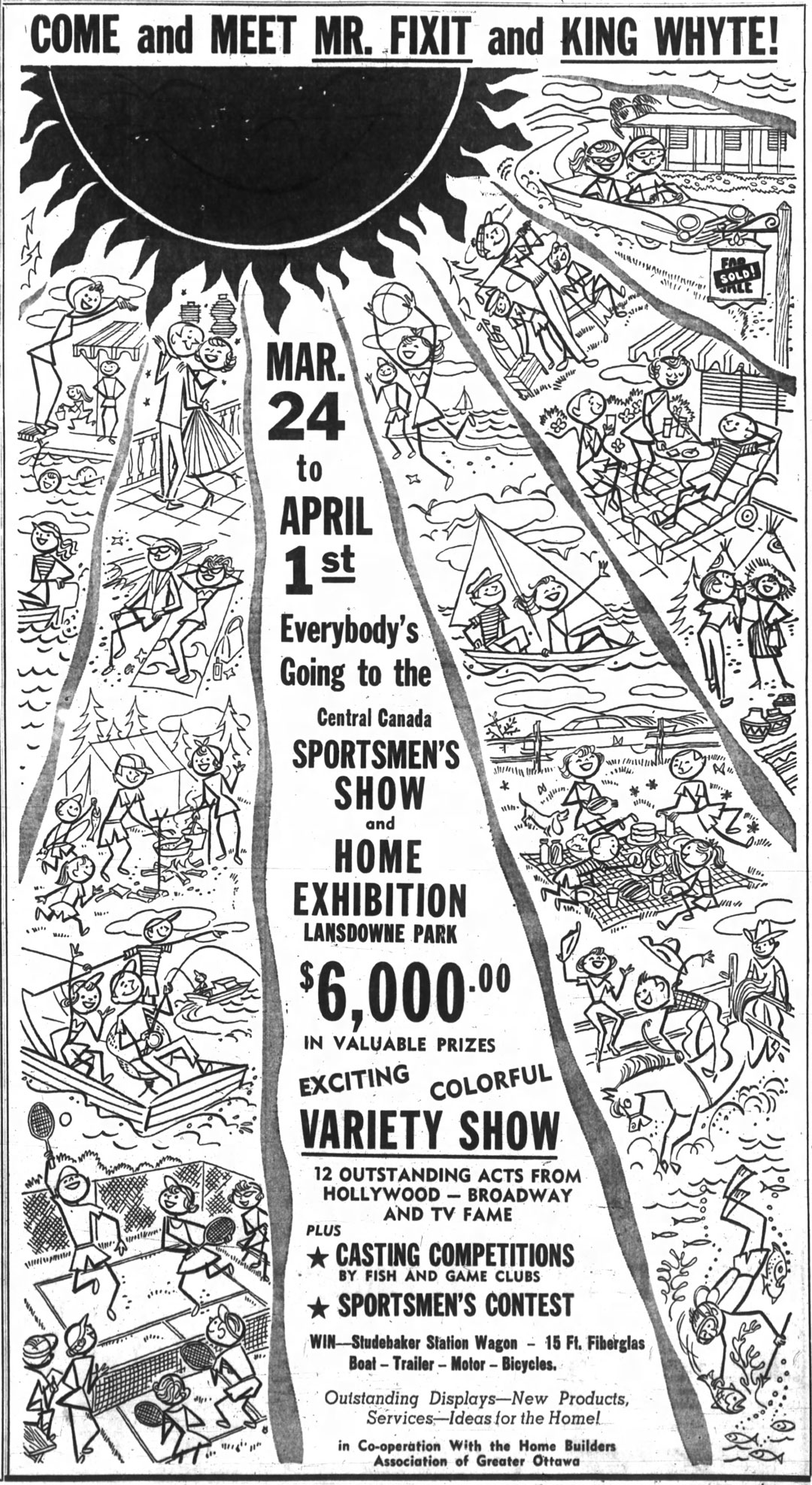
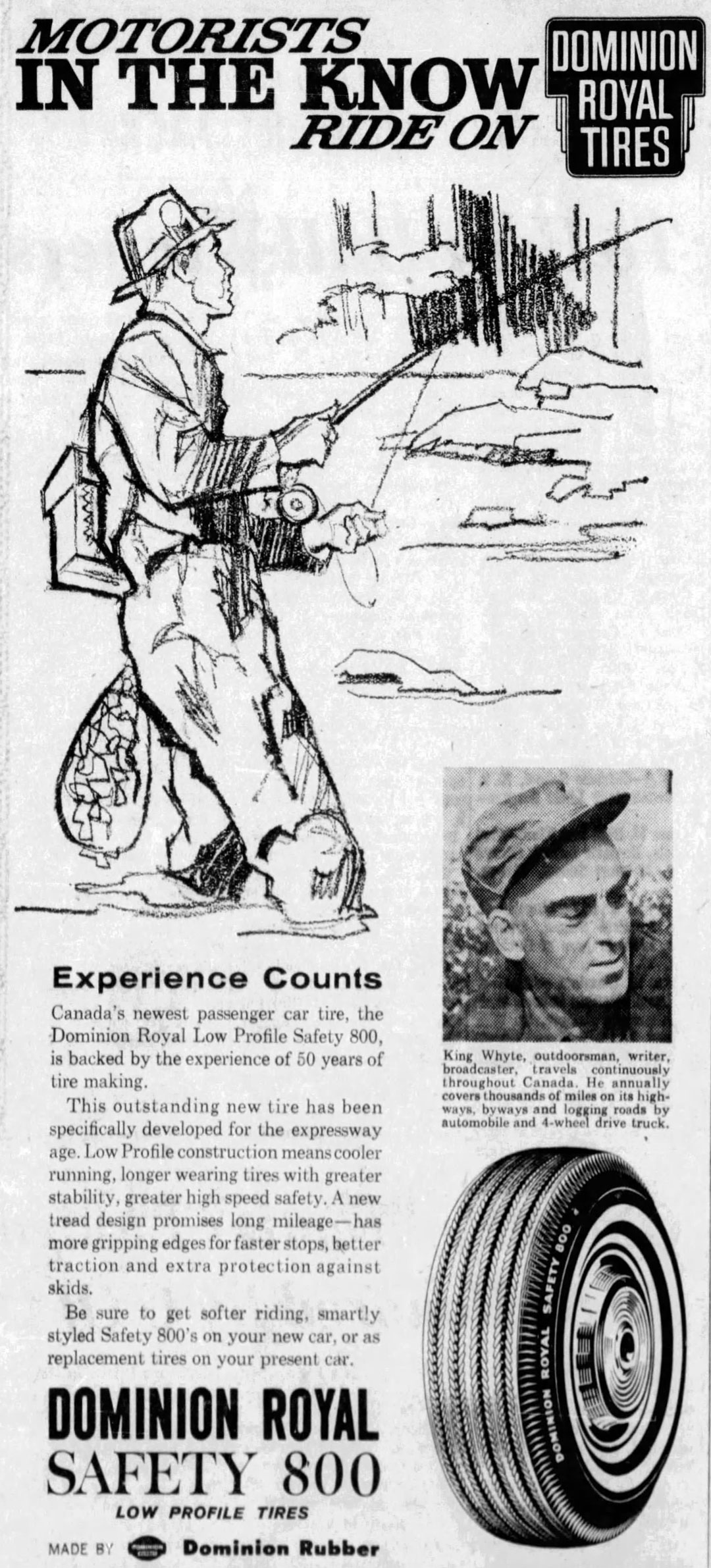
RIGHT: Newspaper advertisement, Dominion Royal Tires, The Ottawa Citizen, a division of Postmedia Network Inc.,
Friday, May 11, 1962, page 18.
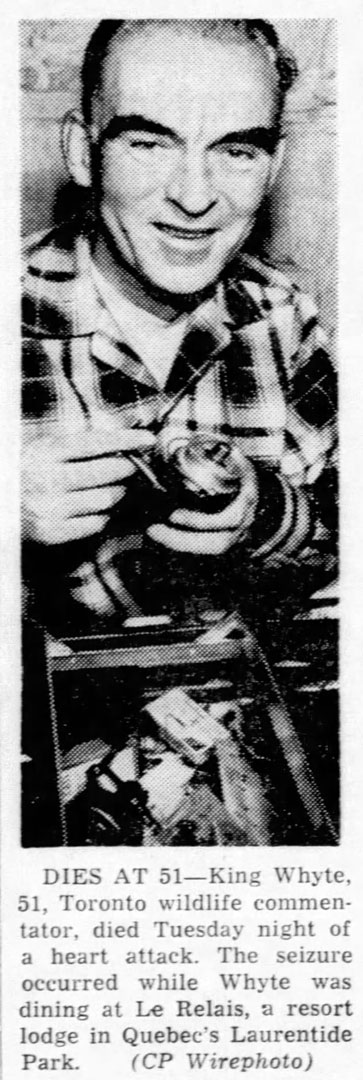
Sadly, it would be at one of these banquets that King Whyte, only 51 years of age, would die of a heart seizure while dining at Le Relais, a resort lodge in Quebec’s Laurentide Park. 26The Windsor Star, Wednesday, June 27, 1962 page 19.
“My mother told me, at the end of the war, he was walking down a street in Germany with a good friend of his who was shot in the head by a sniper. My father wasn’t a combat soldier, he may have shot out windows but he wasn’t shooting at people. But he went and found the sniper, and killed him. And my mother told me how profound that was. Because it had happened so quickly, and they were just talking to each other and his friend was gone.
And, how does that work? And I think for my Dad and his trying to get back into a normal life when he came home. I think the things that would have stuck with him the most are baby Maud, and the soldier in the tank, and his friend on that German street on a sunny day, and the girls he met at Belsen and their father and the horror that he saw. And he was very sensitive to smells. And I didn’t remember that ’til I read the letters.
And so I think it probably shortened his life in the end. I think the war was a burden for his soul. Because you can’t unsee it once you have seen it. And I think a lot of them came home broken.
But, he came home.” Maureen Whyte, Niagara Falls, 2016.
© Dale Gervais 2022

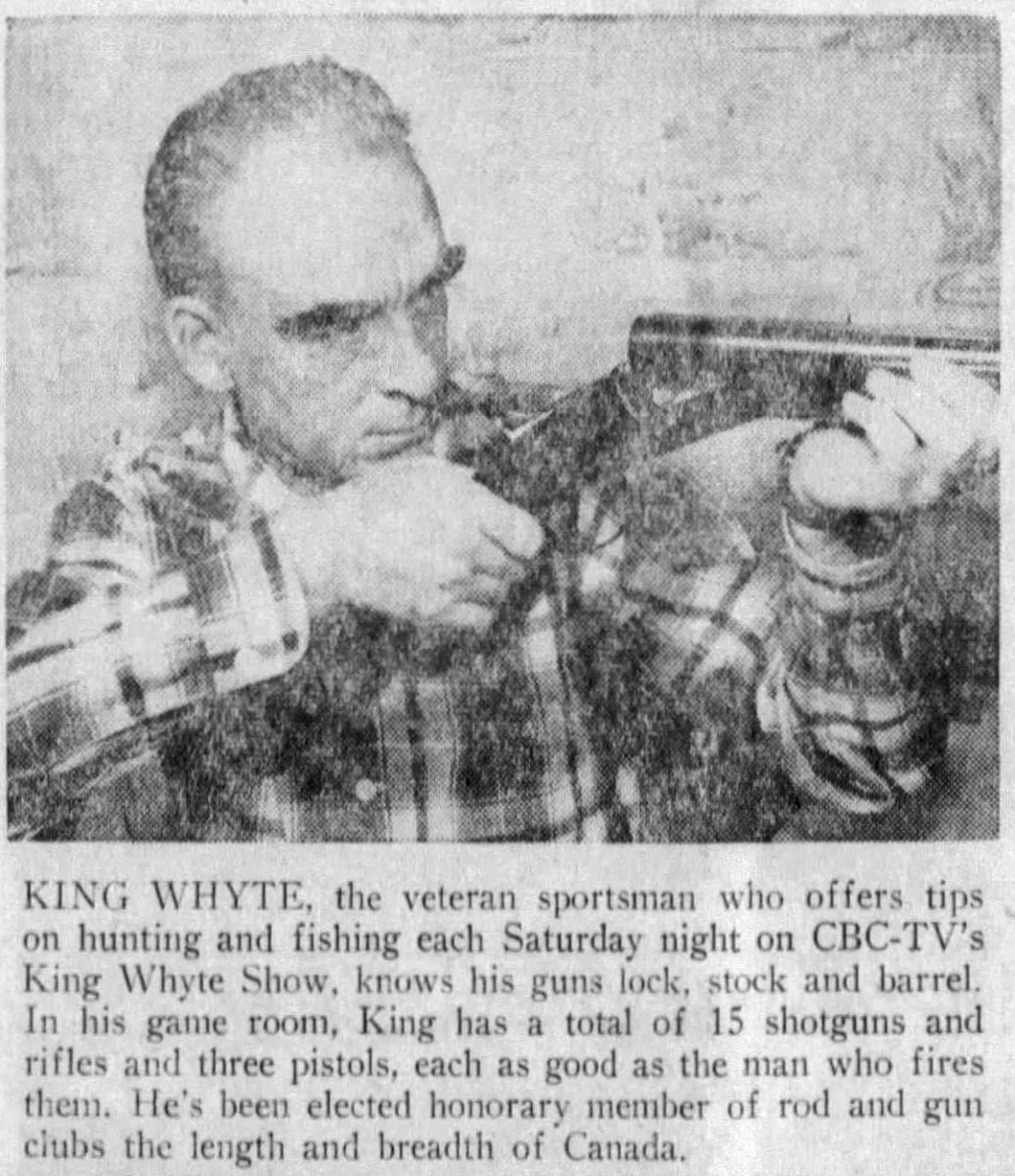





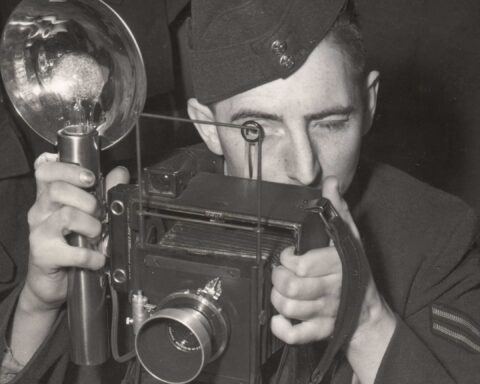


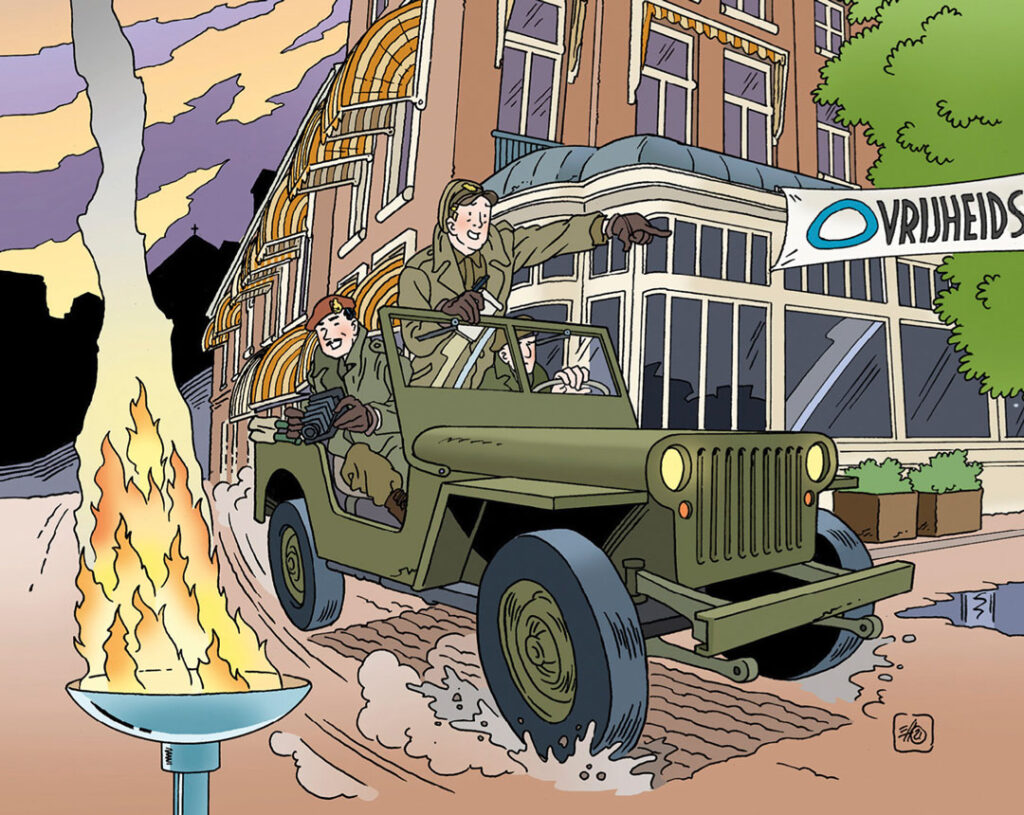
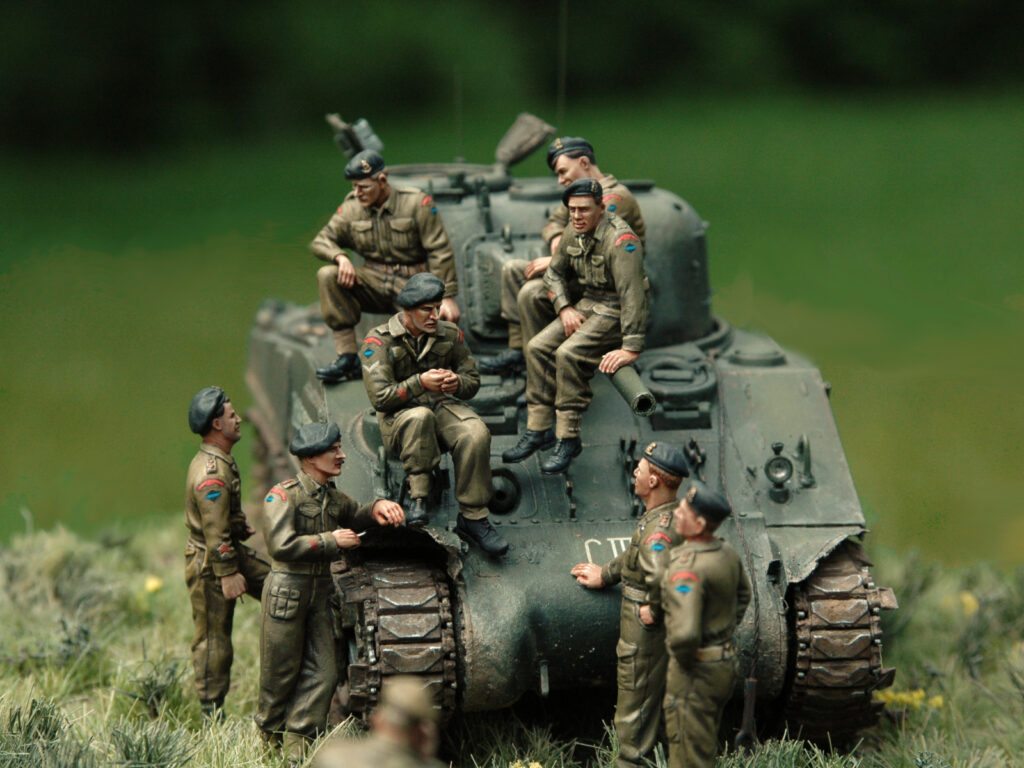



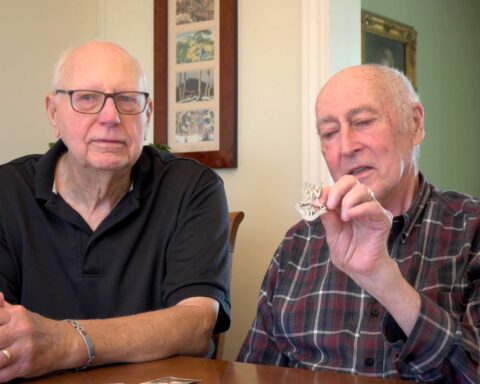
As a teenager from Toronto I worked as a fishing guide and had various duties at King Whyte’s Shoe Fly Lodge forty six miles north of Capreal on the CN line The lodge was on Felix lake. For three summers I met guests from all over the world. I matured as a young man and have many precious memories.
Thank you Don for sharing this! If you ever feel like sharing some of those ‘precious memories’ that deal with King Whyte, I would love to hear them! You can always reach me through the website or directly via email at webmaster at canadianfilm.com – all the best! Dale